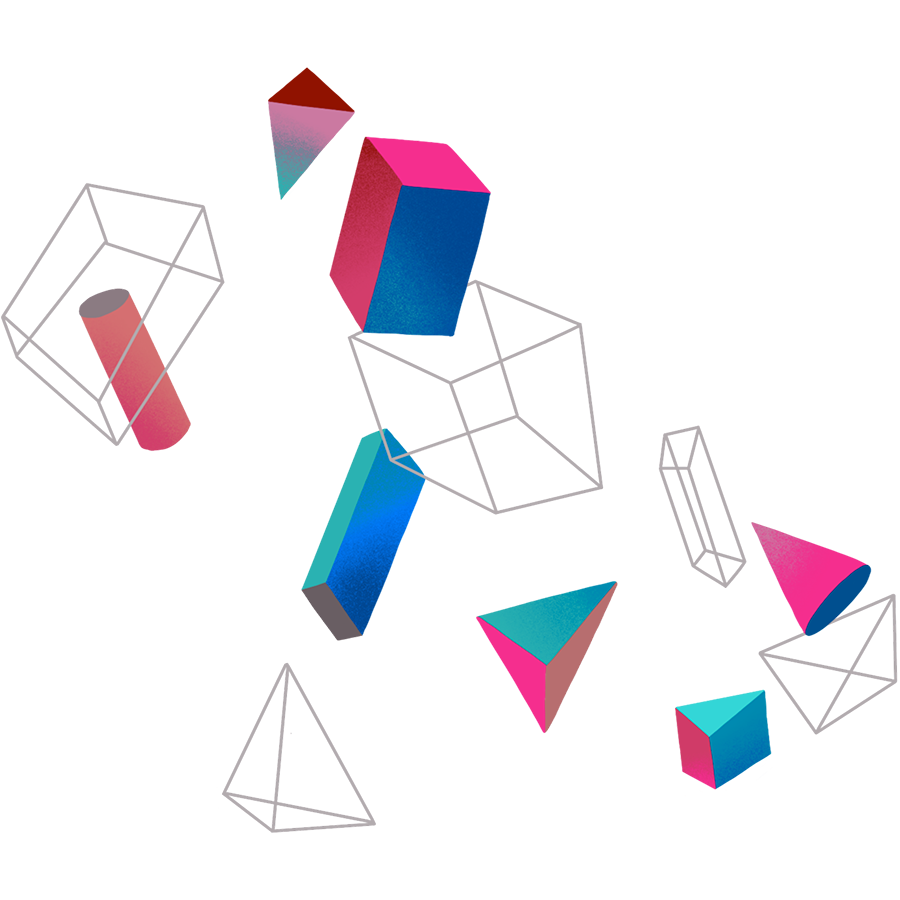Transnational and Postnational Practices Manual
Imagining an artworld “after the national”, this prototype guides you in putting connection before movement in a transnational and postnational art practice.
Read this prototype in French.
Our journey with trans- and postnational practices
For many art workers, working across borders is an essential part of the job. Many of us travel or collaborate across the globe, or invite artists from around the world into our organisations. Even if our organisations or our practices are strongly locally defined, we often relate to what is happening in the broader art field. Discourses and trends quickly cross borders. While working beyond and despite borders, we are not necessarily working ‘inter’-nationally; meaning using our nation states to define us. But rather ‘trans-’ or ‘post-’ nationally; queering or diminishing the importance of national borders by placing the similarities and differences elsewhere than in national identity. We might hope that this perspective brings about awareness, empathy, and inspiration.
However, this kind of movement also holds some risks. Artists, curators, and researchers may have become privileged carriers of new knowledge(s), making overlooked realities visible, breaking down grand narratives, constantly eroding otherness. But the urge to travel, to constantly meet ‘the new’ or ‘the other’ can become an unsustainable practice reproducing destructive tendencies in our society, in the light of climate change, in the light of personal stability and sense of place and connection. During our RESHAPE process, we looked at the risks inherent in trans- and postnational practices in order to work on tools that can guide us towards making connection rather than movement central in our work. Coming from different corners of a continent (Europe) and a sea (the Mediterranean) we wanted to unite our situated experiences. We want to reshape the journey not only to include highways but also footpaths, detours, and alternative routes.
We analysed the unsustainability of trans- and postnational practices as having the following risks:
- Self-congratulatory hypermobility, where the art worker jumps from residency to presentation venue, never really touching ground and taking this mobility itself as a measure of success. This often comes with the risk of exhaustion and burnout.
- The lure of othering and exoticism, a practice where experiences are organized in categories of ‘us’ and ‘them’ within a Western gaze, and every encounter is seen as an exotic novelty, rather than as a personal meeting. Related to this is the creation of an artistic monoculture, where the specific context of arts practitioners is seen as inferior to the ‘festival canon’. Work coming from different places starts to look more and more alike. Specific ideas around ‘good art’ and ‘taste’ or ‘quality’ are being exported, without looking critically at what these ideas are grounded in. The art world is being seen as having a centre and margins, where the margins have to assimilate to the centre.
- Exclusion of those who cannot or choose not to be mobile, either due to visa issues, socio-economic context, or the non-recognition of certain practices as valuable.
- Ecological neglect, due to excessive travelling in unsustainable ways.
- Especially in Covid-19 times we observed a tendency of conforming, everyone moving online at once, the lack of development of other formats, the pressure to continue just like everyone else.
We dared to speculate that these risks represent a strong impact on the mind, our capacity to connect deeply to others, and therefore our political possibility for action.
We exchanged about the following questions:
- What are the dialogues and non-dialogues between nomadic artists and the temporary communities they inhabit? In our search for the other, how can a true encounter be achieved?
- How is travel affecting our personal life and our sense of connection?
- How to recognise dynamics of othering?
- How can travel or exchange increase diversity of practices and understanding, rather than promoting a homogenisation of artistic practice or the establishment of a new canon coming from a specific Western or European gaze?
- Who are given the possibility to travel? Who are not invited?
- How are people traveling and to what extent is the ecological impact of these choices taken into account?
- What actions can be regenerative, on a human and ecological level?
- What is increasing the pressure to act in a certain way?
While trying to find an answer to these multiple issues, something unexpected happened. A novel condition that showed the vulnerability, and the limits of our practices. Indeed, the global pandemic has forced many to be immobile, to live in lockdown. The rapid spread of the invisible threat, its unstoppable journey, has sharpened some questions, and made other reflections emerge:
- In this shifting and unpredictable context, how do we reconnect to each other from a place of isolation?
- How do we extend solidarity when we can’t physically meet?
- How do we create and inhabit spaces of dissonance, where different voices can be heard?
- And how do we develop artistic practices when one of the core premises – that of humans gathering to experience something unknown – is no longer possible?
On the process

drawing by Ingrid Vranken
We started from here: an extensive mind map reflecting on what trans- and postnational artistic practices mean. Weary to generalize, we chose to start from our different personal experiences. What does it mean for each of us? We soon came to understand the vast difference in our experiences. This made us realise that the ideal system or collective that we could envision together, is not necessarily a physical space where we gather or connect directly; it is rather a flexible ecosystem that people can grow themselves, and make it relevant to their different contexts and realities all over the world, in an international or local setting.
During our research we chose to focus on the change-making potential of every single individual within the arts field. Not in a neoliberal effort to redirect responsibility for change to the individual, but rather as a mystical provocation where we believe that every act we perform within our organisations or practice can be an instigator of change. Driven by a radical belief in interconnectedness, we acknowledge that when one part changes, the whole system changes. So how can we tap into that potential?
During our process we did the following:
- Identify the senses that we need to cultivate in order to develop change-making actions.
- Play with these senses in creative and poetic ways, for example by growing plants and observing them, exchanging letters, circulating a box full of personal messages among us and testing the physical and emotional boundaries that keep us apart.
- Create rituals that sharpen these senses and start to practice them ourselves.
- Adapt the rituals to institutional or organisational contexts.
- Form small working groups to receive feedback and speculate through a questionnaire and a survey circulated within the RESHAPE Group of practitioners.
- Analyse the results and create a symbolic system of Archetypes that reflects on these results.
- Bringing all of the work together in a Virtual Exhibition.
We have identified senses we think should be cultivated in order to move towards more mindful practices of (im)mobility, that prioritise connection over production, generosity over extraction. We have developed tools such as Archetypes, represented by a set of tarot cards, Rituals, and finally a Virtual Exhibition where we explore and share a set of models and best practices for a transnational and postnational artistic and cultural field.
By Archetype, we understand a model that gets repeated over and over again in society. In order to change the way we work, we need to change the archetypes by which we structure our practice or our organisation. We chose to develop a set of archetypes based on the Major Arcana in the tarot as it is known in the West. These archetypes were developed in an attempt to flesh out the different ‘senses’ we want to embrace.
By Rituals we don’t mean a metaphysical expression towards another unreachable realm, but materialist practices that connect us to the here and now. Through shifting our attention, the world shifts. Psychological research shows that rituals have actual effects on people’s thoughts, behaviours and feelings. We propose a set of rituals that propose ways to bring the senses and archetypes into our daily lives and work environments.
In the Virtual Exhibition ‘A Complex Journey’ we share the collaborative process with the RESHAPE community. With this experimental mediascape we want to present a constellation of knowledge(s) including our own proposals alongside research texts, artistic projects, organisations and initiatives that reflect upon mobility issues, contributed by various people in the network. This complex journey is unfinished, and remains open with the aim to give you the chance to contribute and be part of it.
Sensing the Journey
We propose thinking through the metaphor of the journey, a journey that we take to create the change we need to see in our work. We do not want to set off on our journey with our eyes and ears closed. We decided we needed to develop some additional senses in order for the journey we propose to be regenerative. To counter the issues within (im)mobile artistic practices, we have identified five senses that could be tools in leading the way in our search for change: sense of Place, sense of Multiplicity, sense of Connection, sense of Generosity, and sense of Break.
Each of these senses responds to a particular problem, is linked to several Archetypes (elaborated in the next chapter) and is addressed through several Rituals (idem). We chose to work with senses in an attempt to follow feeling and bodily experience over cognitive processes, and move away from the moral or judgemental connotations of values or principles.
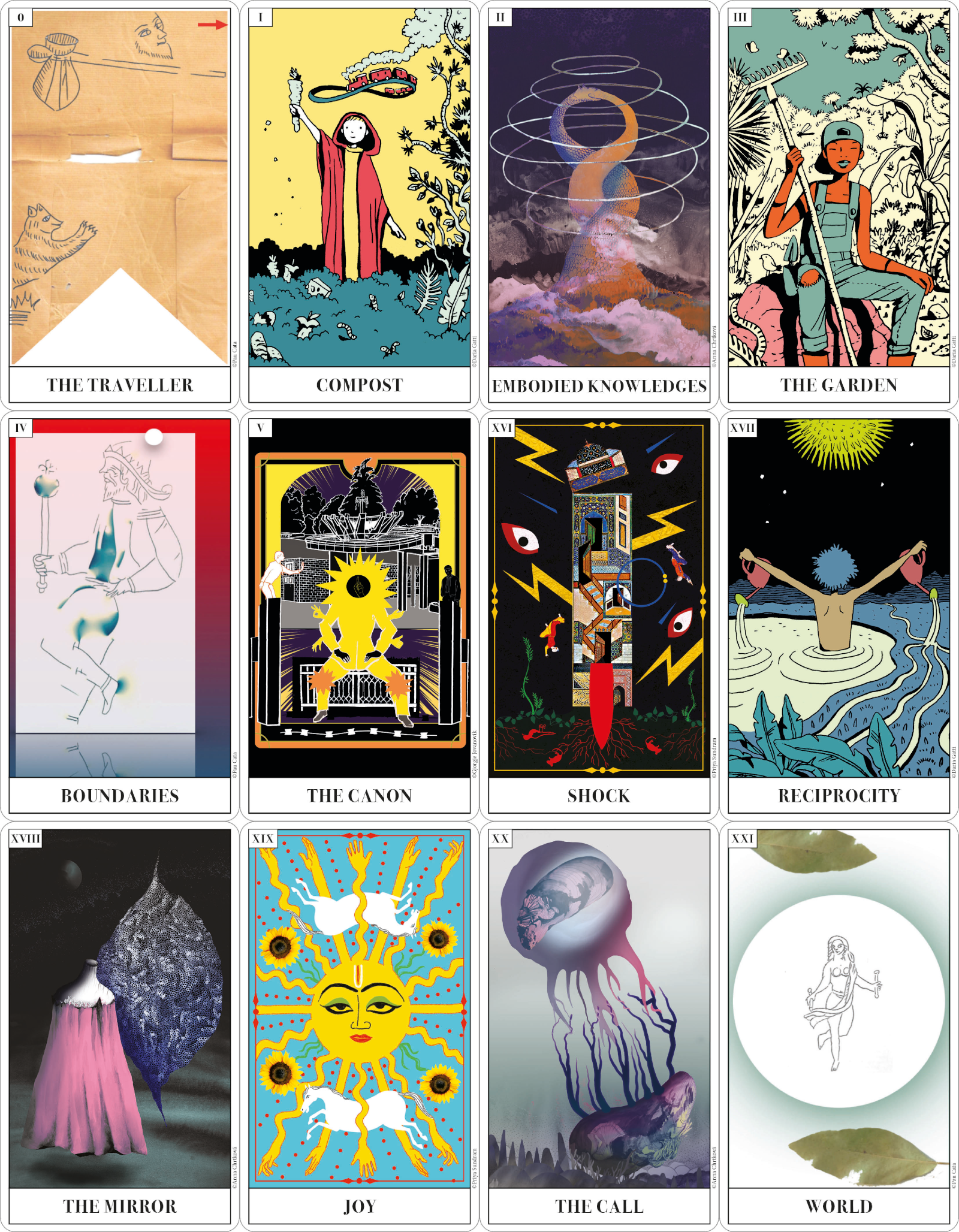
Sense of Place
We came to sense of Place, from a concern around hypermobility. When hopping from one country to another, or when in isolation, do we actually know where we are? Do we know how to create a relationship with where we are and who else is there? To know what it means to be in relationship with our surroundings, we wanted to learn from plants, those who grow from their environment, translating their surroundings into their form – each leaf expressing the way in which the light moves throughout the day, each root a calligraphy of where water can be found. By growing from an environment, the environment grows through you. Can mobile art-workers grow from the environments they are in, in the same way as plants do? Growing a sense of place could mean an increase of attention to the contexts in which we are working, who is part of that context, and what our own role is in that context. How does our context express itself in our work? Can we leave the places we work better than we found them? Sense of place pushes us to create long lasting relationships through and within our work.
In reaction to: hyper-mobility
Archetypes: The Traveller, Boundaries, World
Sense of Connection
We came to sense of Connection when talking about exclusion of those who cannot be mobile, or choose not to be. Sense of Connection desires to find ways to be together, to support each other, even if we cannot meet. By sharpening our sense of connection we would like to have more attention for who is not present, and how to include absent voices. But also how to fully appreciate everyone around the table in our working environment, and not make anyone feel invisible or unimportant. Sense of Connection could mean to make sure we document our processes, that we share what we know, that we make time and space for informal meetings and checking in with partners, former collaborators, and so on.
In reaction to: exclusion
Archetypes: The Mirror, The Call, Embodied Knowledges
Sense of Generosity
We came to sense of Generosity when talking about ecological neglect. How can we foster a radically generous way of being in the world? So rather than taking (from each other, but also from the earth itself in the sense of raw materials), we can focus on nourishing and care-taking.
Can we imagine ways of art-making and art-presenting that produce access and provide the conditions for both artists and audiences to thrive, to connect, and exchange? A practice not only concerned with its own life forms, but making life possible for others – human and other-than-human alike.
If we want to commit to that, we might want to start thinking about how we travel, how we feed ourselves, where the materials we use come from, but also how we treat each other and ourselves. When thinking about generosity, within a system that has brought so many people to burnout, we feel vulnerable ourselves.
Within our organisations and practices we might find space to create a generous attitude within a system that we recognise as exploitative, and speak out when we see or feel exploitation.
In reaction to: ecological neglect
Archetypes: The Garden, Reciprocity, Compost
Sense of Multiplicity
We came to sense of Multiplicity through discussing homogenisation of artistic practices and a lack of awareness of or interest in other value systems. We’d like to ask how we define the common ground and who is being left behind its frames? How to make sure to be open to the diversity of perspectives and standpoints, especially the ones we might not know how to read? Can we keep renegotiating the frames of our organisation/programme/institution? How can we invite different perspectives into our practices, and consider ourselves students again? Sense of multiplicity challenges us to step out of hierarchical value systems and find ourselves holding space for many voices and perspectives simultaneously.
In reaction to: artistic monoculture, othering and exoticism
Archetypes: Beyond the bloody ego (see Fair Governance), The Canon
Sense of Break
Sense of Break emerged from the experience of Covid-19. Many things stopped and at the same time, the pressure on many art workers increased. The differences and inequalities already present were made even more visible. The push to conform to online models and a sense of ‘continuing as normal’, made many of us feel alienated from our work. Sense of Break proposes a moment of pause. Not to relax, but to suspend action and observe first. Sense of Break acknowledges these moments in which we cannot make sense of it all; it sees the potential of chaos and disruption. Sense of Break is about the experience of burnout or the pressures to conform and move on that most of the art workers and practitioners are facing.
In reaction to: conformity and burnout
Archetype: Shock, Joy
Walking with archetypes and rituals
Both the Archetypes and the Rituals are imagined as tools for artists and art-workers, to use as means to shift focus in their daily life and work. The tools are designed to be adapted depending on the setting of the practice (on an individual or institutional level). We have some suggested uses, but they are first and foremost an invitation to play and observe.
The journey itself is a well-known Western archetype, a narrative repeated over and over again, from the Greek epos and the medieval songs about knights to action-hero movies, a story that is continually retold, footsteps that many of us follow when we narrate our own lives. But the archetype of the journey also appears in many Middle Eastern cultures, often related to seeking the path of God, of truth, of purification, self-discovery and growth. Going on a journey means observing where one is, cultivating a desire for the unknown, collecting the courage to step out, growing through encounters, and coming back changed. It is this archetype of the journey that also appears in the tarot. The tarot tells the story of a figure setting out, naive and hopeful, encountering many entities and experiences, translated into 22 Archetypes. Each of these encounters holds the possibility to view the world differently. Each Archetype invites the reader to look at the situation from a different angle, to be aware of blind spots, and find the potential for change. It is this journey that we would like to repeat here, with new archetypes – drawing from the traditions of the tarot as used in the West, but re-imagining them through the senses we want to cultivate.
We present our archetypes in the same order as in the Rider-Waite or Marseille tarot deck. The Major Arcana was split up between Trans-/Postnational practices and the Fair Governance – The Governance Of The Possible trajectory. The Major Arcana is split into two approaches, one focusing on the individual position, and one focusing on collective governance. These two journeys meet up in one set of cards. In this document we will be presenting Archetypes 0–5 and 16–21.
Each Archetype is joined with a Ritual. The function of Ritual in the community is that of providing practical actions to change our relationship with what surrounds us. With the introduction of Rituals we propose playful ways to bring the five senses and the proposals of the Archetypes into our daily lives and work environments.
0. The Traveller (based on The Fool / Sense of Place)
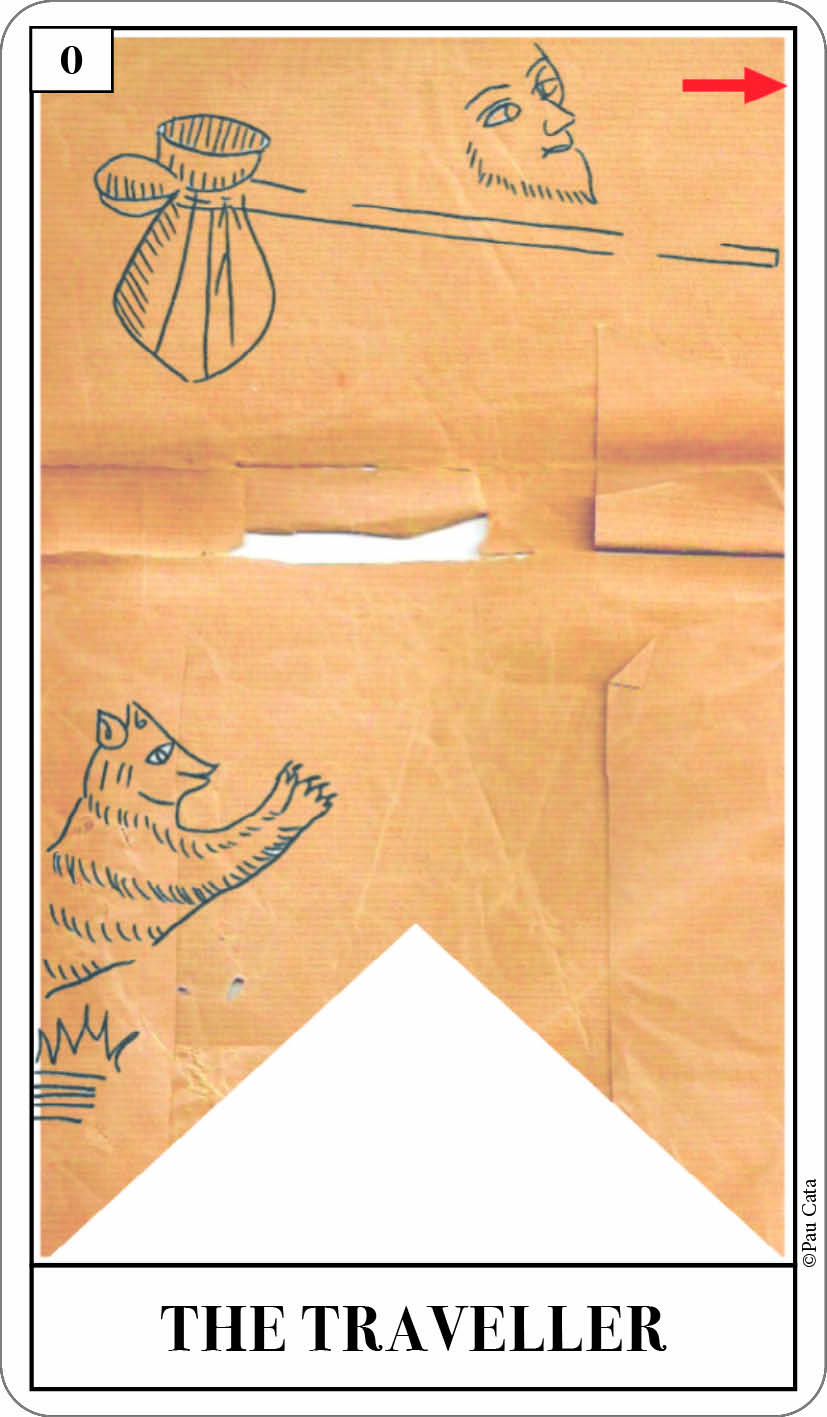
The Traveller is a searcher for new beginnings. Although enthusiastic and exuberant, the traveller can also be a bit naive, stepping into the unknown, believing in good outcomes. Wanting to escape locality, the traveller is privileged to hop from one place to the next, but risks attaching self-worth and the idea of success to how much and how far they travel. This condition is often precarious and the traveller can become exhausted. The speed at which they push themselves forward into the next ‘somewhere’ does not allow for place to materialize. Ready to board yet another plane, they may be missing what is happening closer to home, or in their folly of networking, may be devoting less time and attention to each contact they make. The traveller invites us to stay both courageous and naive, but not forget to look around us and see who is traveling together with us, who might be warning us for dangers ahead. The traveller tells us we are always travelling somewhere, a place that needs our care and attention too; and we are never traveling alone.
The archetype of the Traveller invites us to ask ourselves: What does the promise of mobility mean to me? Where am I rushing to, and what do I expect from it? What do I take with me on my journey? Who is joining me on my journey? What are the things around me that I am not seeing? Where can guidance be found? How am I travelling and what is the impact of this method on my environment and/or my connection to place? How do we learn from and enrich the places we travel through?
Associated ritual: the hidden ayat — Although meaning ‘verses’ when using the Quran, it is doubtful whether ‘ayat’ means anything other than ‘signs’, ‘proof’, or ‘remarkable event’ in the Quran’s text. The ‘signs’ refer to various phenomena, ranging from the alternation between day and night, rainfall, or the life and growth of plants.
We propose to challenge the integrity of the status quo, to inhabit ambiguity and that which is hidden, activating not-knowing, the spaces in between.
- Look for pencils, scissors, colour pens and markers, tapes of different sizes, or just a piece of blank paper to write on. If needed, look for a supply store and buy or borrow what is needed, always in moderation.
- Once back to your nest, either temporary or not, concentrate on the textual or visual message you want to pass through.
- When you are ready, take this creative trace, your ayat, and hide it.
- The process of hiding has to be also a way of commencing a guidance, to reorient.
- Once you find the hidden place, leave the room and go for a short walk. Do not expect much, just forget about it or wander, your imagination can indeed guide you to other lands and possible outcomes but the possibilities you know of the effects and continuity of your creative act, your ayat, will most probably remain unknown, enhancing indeed magic.
1. Compost (based on The Magician / Sense of Generosity)
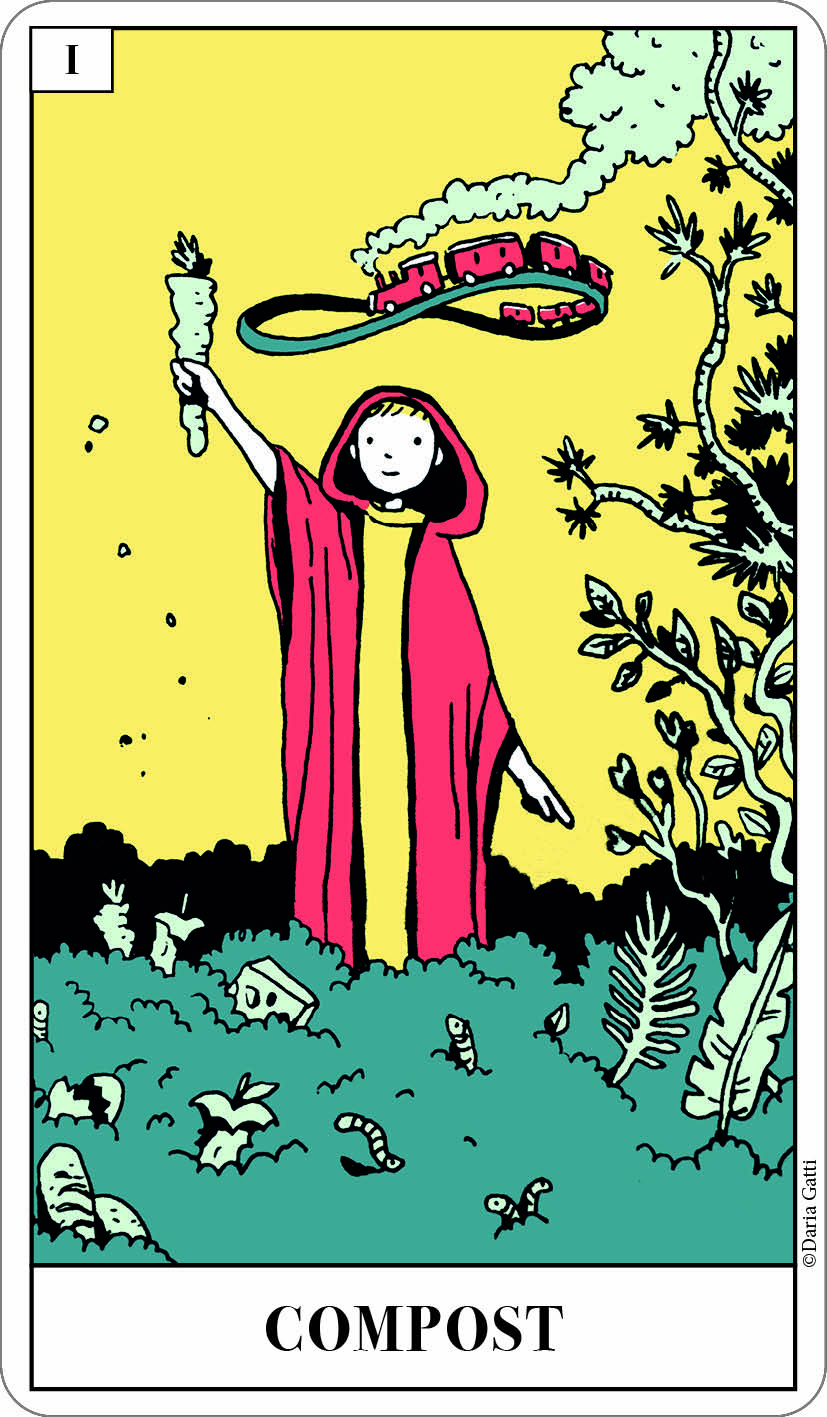
Compost is magic. Compost sees the potential in what others consider garbage and knows how to wield and transform the material it is given. Compost asks us to stand still and look at what is already there. What is it that we have accumulated? What seems mundane, maybe even trash, could be powerful tools and knowledge, holding the potential for transformation and growth. Compost looks at the material world and sees it as a playground of infinite possibility and creation. As an artist or art-worker we might not always recognise the mountains of knowledge(s) and skills that we have already gathered within our practice or our organisations. But also, in what ways are our organisations and our practices already composting? To what or whom are they fertile grounds? Everything we need in order to change our practices might already be there, we just have to apply ourselves differently and also see our failures and mundane tasks as the places where transformation can be happening. Compost also reminds us that death is not the end, that we must trust that the traces we leave will be the superfood of others. Compost proposes the practice of rituals, in order to transform the daily into the magical.
The archetype of Compost invites us to ask ourselves: What do you want to change? Are there places or examples around you where you see that change is already happening? What is the environment that I have created for myself/for others? What kinds of nutrients does it offer? What would ‘ending’ mean for me? What traces would I/my organisation leave? What would happen after the ending?
Associated ritual: hosting and rooting — In response to the sense of Generosity, a set of rituals are designed to help to be rooted in your environment and/or hosting and sharing your resources and knowledge with your peers/ guests.
- Before the guests come to your place, try to research them, find out more about their project, their personal passion or dream, and during their visit try to incorporate something (activity, or topic of conversation or special food) relevant to that. Share this process with them.
- Before the guests arrive, create a playlist of local bands and artists. Send it to your approaching guests so they can listen to it on the trip. Before the guests depart, ask them to create a playlist for you. Listen to it after they have left.
- When you travel to a new place, reserve the first day to take a walk in the city. Do not use a map! Become lost in the streets. Walk as much as you can. When your time is up, speak with local people and ask how to get back to your accommodation.
- When returning from your travel, ask your friend or colleague to pick you up at the bus/train station or airport. Spend some time with this person, visit a cafe in the local area of your home, talk about your travel and listen to the news from your hometown. Let yourself experience the warmth of returning.
2. Embodied Knowledges (based on The High Priestess / Sense of Connection)
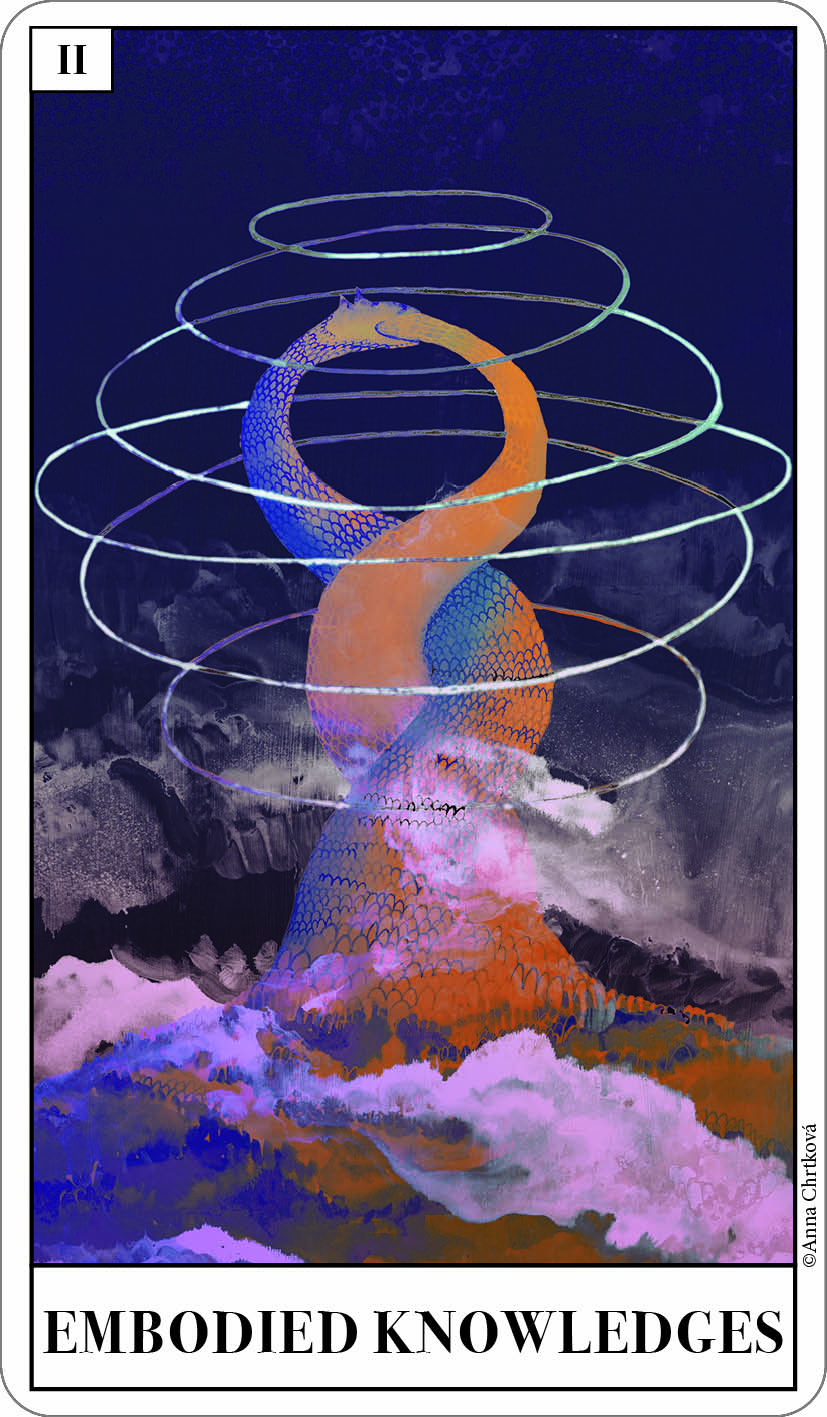
Knowledge is very often perceived as one of the most valuable things in our lives. Many people identify themselves with their knowledge. However, often one kind of knowledge becomes privileged over another, or one might not even recognise the different knowledge(s) one holds and works with. ‘Embodied Knowledges’ appears as an invitation to shift our attention to what is underneath the surface. This card invites us to be students again, and connect to an inner knowing, rather than learned skill sets and procedures. ‘Embodied Knowledges’ can be thought of as the knowledge of the seed – a seed ‘knows’ when and how to grow, but only at the moment it starts growing. This inner knowing does not follow a clear pathway thought out in advance. A seed feels its way up, taking decisions in relation to the circumstances it encounters, from the dark underground into the sun.
‘Embodied Knowledges’ invites us to ask ourselves: What knowledge(s) are present in my practice/my organisation? Which knowledge(s) are missing? How can I know through my body? If so, what does my body know and how? What kind of bodies carry knowledge? How can the knowledge(s) in my practice/organisation be activated, shared and distributed so they won’t be collecting dust in the archive? How to make the bodies cooperate and make their knowledges benefit from each other? How to make decisions from a place of feeling and observing?
Associated ritual: The Walk — You are written by your environment. Allow yourself time to connect to it. To the area you are familiar with, you are bound to tightly. The Walk is a proposal to look closer. To perceive the changes, to perceive the previously unnoticed. To re-enact your memories and knowledge of that area.
- Clear your mind. Try to forget what you know. Dismantle the patterns that you apply when going in the area. Close your eyes. Take a deep breath.
- Disorientate yourself. Go into the streets you don’t tend to visit normally. Accept the Walk as a process, not a tool to go somewhere. The purpose is in the action itself.
- Stop at the places you always overlooked. Don’t be afraid of the dirt, of the ugly, of the glamour. Become blank.
- Dive in. Search for symbols, signs, new relations between things that are present. Imagine things that are missing. There are no rules. Assign new meanings, create your own structures and connections. Apply your senses. Sight, hearing, touch, smell, taste.
- This is a time designated just for yourself. Your guide is the environment itself and your vacant intuition.
- You walk, you perceive, you experience.
- When you feel it is time, slow down. Close your eyes and take a deep breath. Let your past memories, structures, and patterns flow back in. Re-orientate. Say aloud the name of the things you see. Name them.
- Return to the initial point. Smile to yourself. Get back to your routine.
- The Walk is finished.
3. The Garden (based on The Empress / Sense of Generosity)
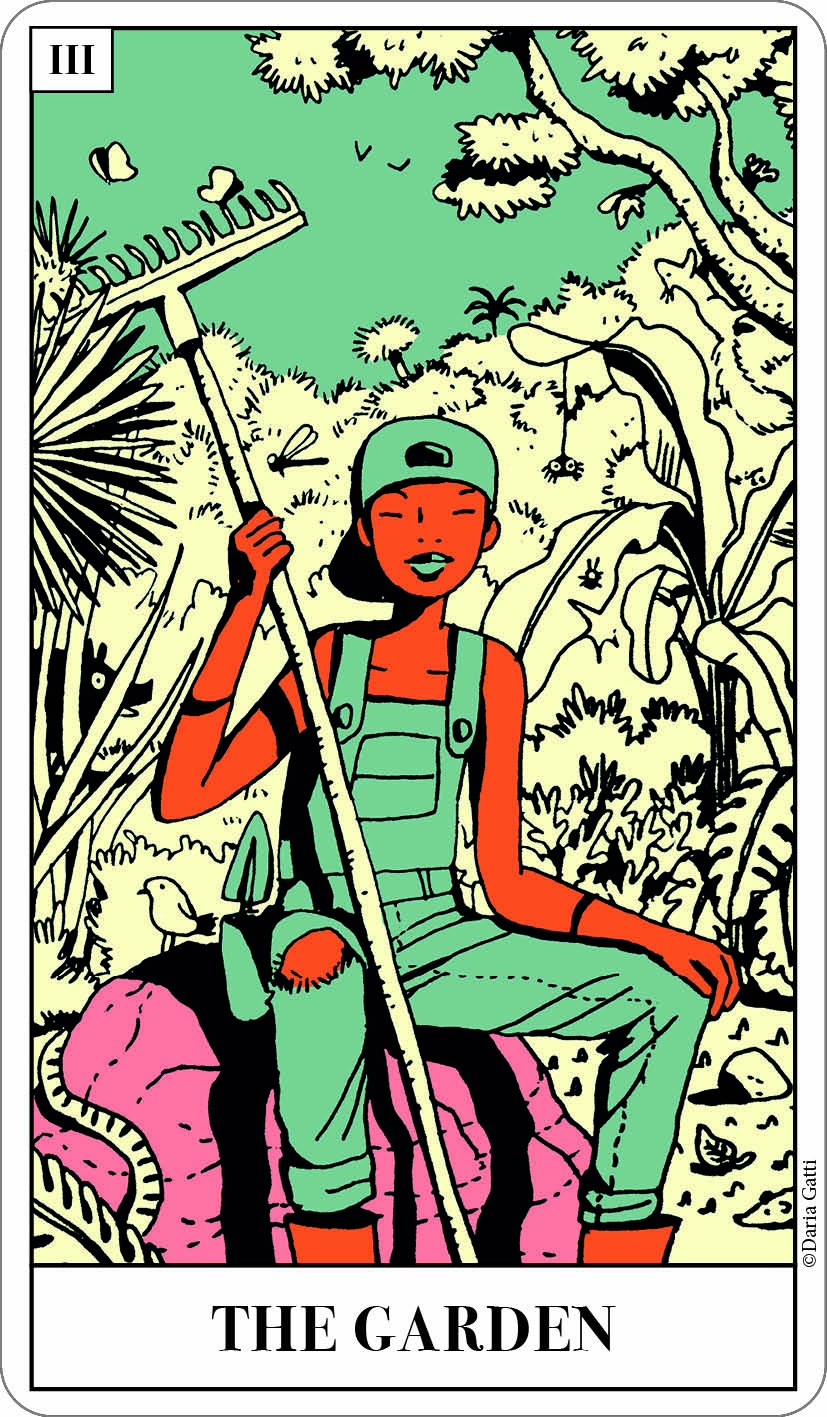
The Garden represents a space or a state of abundance, which comes from the capacity of creation and regeneration. The garden can be abundant because it is constantly transforming, constantly in movement and in communication with all parts of its ecosystem. A healthy garden allows for different stages of growth simultaneously. For a garden to be healthy it needs a multiplicity of species and rhythms. The garden invites us to not only enjoy this abundance and diversity, but also to tend to it; no garden without gardeners. The garden invites us to think of our responsibility and our role in the creation of the possibility for all life to thrive.
The Garden invites us to ask ourselves: Who is being generous to us? Who are we being generous to? How are we connected to our surroundings and how are we tending to it like a loving gardener would? What can we learn from the other-than-human presences around us? What are the various rhythms in my practice/my organisation? How to make space for different rhythms to thrive?
Associated ritual: attuning to the vegetal world — In this ritual we will explore the connection to each other through our connections with the vegetal world. For the next few days, choose a vegetable that is in your surroundings. This might be a tree, a plant, some grass.
- Take ten minutes out of your schedule every day, for at least ten days, to observe this vegetal being. Observe it from close by or far away. Make sure you are feeling the ground firmly underneath you as you are observing.
- Take a picture every day and write down or make an audio recording of what you have observed.
- Share these observations with a fellow practitioner of the ritual.
4. Boundaries (based on The Emperor / Sense of Place)
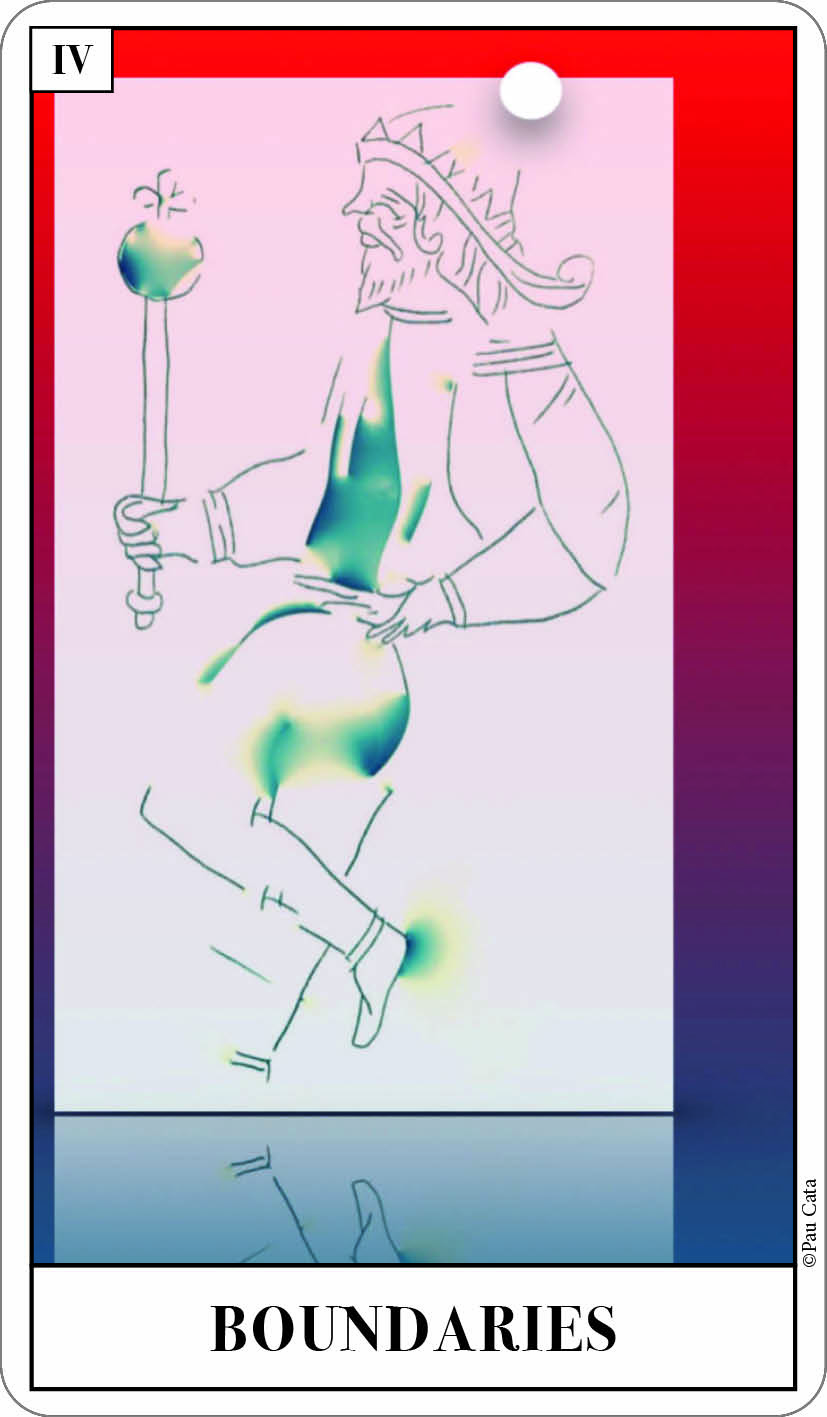
When travelling one will inevitably reach or cross boundaries, whether they are borders, schedules, or the boundaries of one’s own body and energy. Boundaries proposes a reflection on that state in between, where the connection to one’s surroundings is lost. Something is holding one back, something becomes stuck. In this state, the self often becomes the only stable entity. The archetype of Boundaries proposes a reflection on how and when we fold back onto ourselves, and how this influences our actions.
Boundaries invites us to ask ourselves: What boundaries have you encountered or crossed? What practices do you encounter and/or reproduce that might neglect or cross their boundaries? In what state do you feel most safe? How do you practice care? Are you afraid to slow down, to stop performing? Are you afraid of uncertainty? What kind of uncertainty and why?
Associated ritual: mapping possible routes — Before your guests arrive, either physically or digitally, take the time to think about what they would need to know about in your surroundings. This might be the local bakery, a nice park, a beautiful house, a spot that always makes your heart melt, a place with a sad or a happy memory. What would you like them to see, visit, make use of?
Take pen and paper, maybe different colours and hand draw a map of your surroundings that includes these places. Include details that are important for you. Walk your guests through the map on their arrival. Ask your guests to add to the map at the end of their stay and pass it on to others.
5. The Canon (based on The Hierophant / Sense of Multiplicity)
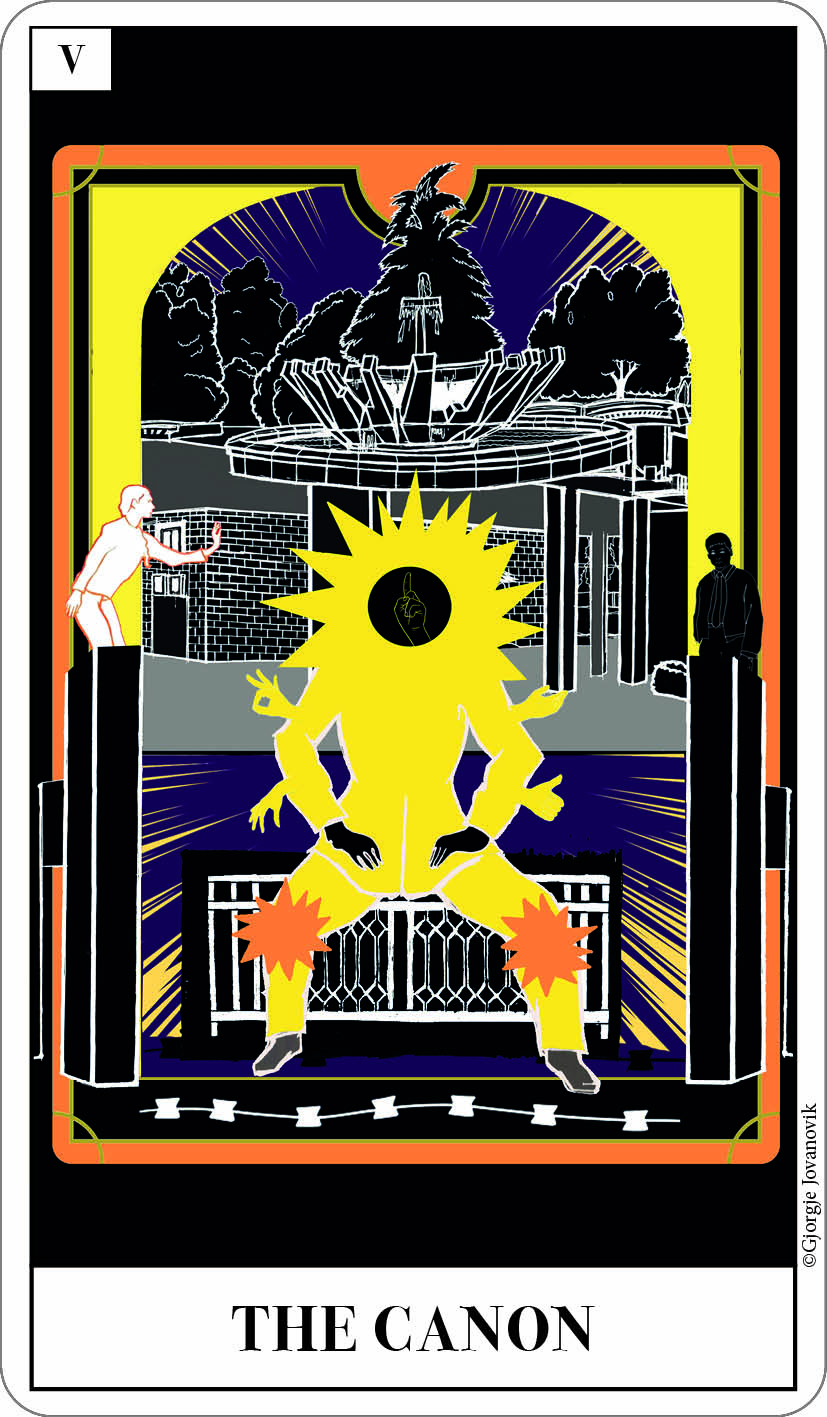
The Canon represents a set of practices that shape our everyday work or a framework of what is being visible and audible in our surroundings. A canon is actually a very performative notion: it is not formed by any natural laws; it is never granted nor unchangeable – no matter how solid it may seem. On the contrary: it results from a certain social contract, a result of someone’s decision what to include and what to leave out, invisible, and inaudible. Who is making these decisions? How and with whom are they negotiated? And, last but not least, whose interests do they serve and whose needs do they tend to neglect?
The Canon invites us to ask ourselves: who are we talking to while shaping the programme and the structure of our organisation? What dialogues and non-dialogues took place between the communities we inhabit, temporarily, or on our everyday basis?
Have a look at the festival programmes in your localities. What are the artistic practices that are often presented, that are invited to other places, that travel and thus get their visibility? How does the canon of most successful (or, rather, most often presented) performances shape the basic aesthetics and production frameworks? Do they cherish the diversity of perspectives or lead to flattening and homogenising aesthetic expressions? Who is or isn’t invited? Who remains excluded, either through criteria of selection, access to finances, or international diplomacy?
Have a look at your (artistic) practices: which are the canons shaping it? How can we continue to create and inhabit spaces of dissonance, where different voices can be heard, and can communicate with each other?
Associated ritual: standpoint invitation — There is a framework from feminist philosophy called ‘Standpoint Theory’. It posits a direct relationship between people’s structural location in the world and their understanding of the nature of the world. The further one is from the centre of power, the more comprehensive one’s analysis will be. This is because those who are marginalized have to understand the viewpoint of the dominant groups, while those in the dominant position have no need to understand the perspective of the ‘oppressed’. In other words, certain groups may be marginalized (based on disability, gender, sexuality...), but their insight represents anything but a marginal discourse. They may be marginalized, but their contribution is not marginal.
Look at your practice, your institution. Take a paper and position yourself (your institution) in the middle. Now use the rest of a paper to put down various groups and communities (call the archetype of The Canon to help you identify these groups). Place them around, above, below the central point in a scheme is such a way that the closer they are, the more present their voice is in your work. If they are not present at all keep them at the edge.
Now choose one of the groups or communities on the edge and reach out for it, find someone who represents the community. Maybe the person you are looking for is not in your direct network; in this case – expand. Ask your friends, your colleagues. Find a way to contact such persons and invite them for a coffee. Open yourself up to listen to what you might have been overhearing. Pay them for this labour.
Practice this ritual at a time you are about to start a project (a festival, new performance, new open call).
Variation: collaborate with these persons. Let them take over your position for a day, for a week, a year, for always? Pay them by the same amount you would earn in such time. See what might be changed.
6. Shock (based on The Tower / Sense of Break)
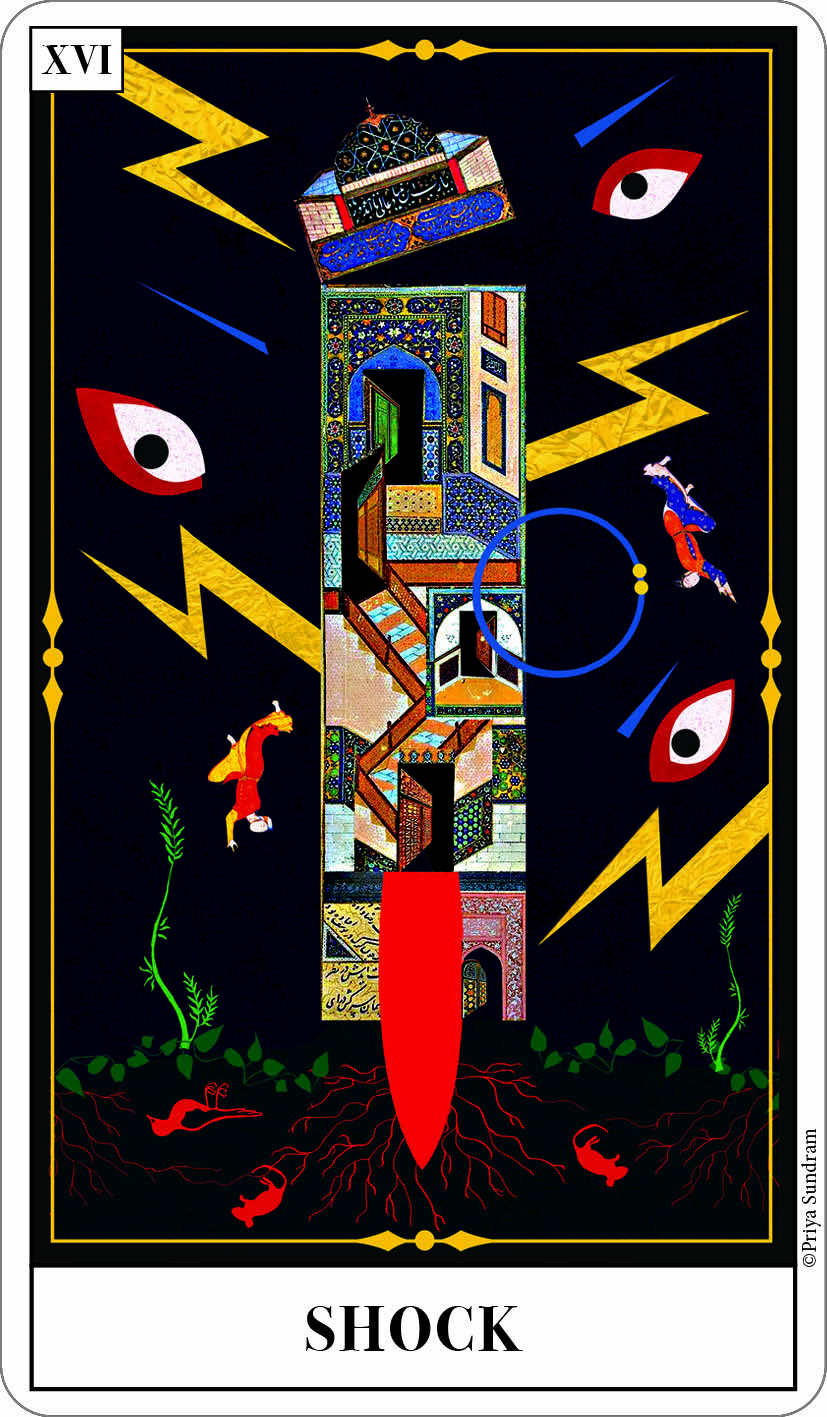
The archetype of Shock represents the shaken stability, a sudden cataclysm, but also change that can enable new ecologies. The unusual perspectives and multiple doors compound the idea of confusion, of finding ‘the right way’, many different ways. The ‘storm’ references the Hindu goddess Kali, symbolising destruction and rebirth. A very powerful energy in Hinduism, an ultimately one, a positive force. This confusion, shock, destruction, makes way for new beginnings, new connections, and growth. However thick we build our walls to shield ourselves or our organisations, change will always come, and in these moments, we need each other. However stable your institution might seem, you may have to rely on its porosity rather than its stability. For Merleau-Ponty, an institution exists to make experiences last. Building/establishing our own institution is a matter of creating a framework to allow continuity, to give back to everyone their own responsibility. An institution can also be imagined, not as a rigid tower, but as an organic cluster of vital functions, containing a certain critical mass that may be flexible enough to have space for change. For inspiration we could look at the trees; towering above, but intricately connected through a fine system of roots. Trees grow strong and stable, but are also flexible enough to bend with the winds or change their direction according to the clearings in the canopy.
The recent crisis provoked by Covid-19 has sharpened our journey and made this questioning even more relevant. All of a sudden, we (hyper)mobile cultural workers find ourselves unable to move and in a situation of isolation.
Shock invites us to ask ourselves: What changes can I see on the horizon? Am I scared of welcoming change? What false beliefs run through my days? What does stability mean to me? What does flexibility mean to me? How can we reconnect to each other, to our surroundings, to unknown others from a place of isolation? How can we extend solidarity when we cannot physically meet? How may a crisis open new doors? How would I shape my work/organisation if tomorrow I would have to start all over?
Associated ritual: the letter to oneself — This ritual can be practiced at any time, but is recommended as a moment of pause after a shock or after a period of exhausting work when things get back into their normal routine. Instead of thinking about the system and its rules, following them and neglecting yourself and your wellbeing. Reserve an hour and a half or two just for yourself. Create a serene atmosphere with a cup of coffee or tea or a glass of wine. Sit on an armchair or any place you define as comfy.
Now think of your activities. Use colour markers and draft a map of the network you are part of. Outline the structures you have been creating with your practices or the structures you are involved in. Indicate other people who are in those structures with you – your colleagues, fellow artists, employees, designers, producers – all human (as well as other-than-human) beings that you are in daily contact with, beings that are co-defining who you are and what you do.
Now close your eyes... and exclude yourself. Exclude yourself from all the structures, erase yourself from the network, let a blank space replace your position...
... now you are outside, you no longer belong to the structures.
Take a paper, a pen and start writing a letter. Address it to a person who carries your name. Write an honest message in which you describe why you would like to take over the blank space in the structures, in the network. Do not hesitate to take a critical tone. What would you change if you have this position? The privileges it brings? How would you treat this position? If you want to go deeper, focus on accessibility – imagine yourself to be in a socio-political-economic handicapped situation – what needs to be changed in the structures so you can be part of them?
Finish the letter. Empty your drink. Put the letter into an envelope and write down your name and address on it. Take a walk to the post office. Buy a stamp and deposit the envelope in the postbox.
Resume your everyday routines.
7. Reciprocity (based on The Star / Sense of Generosity)
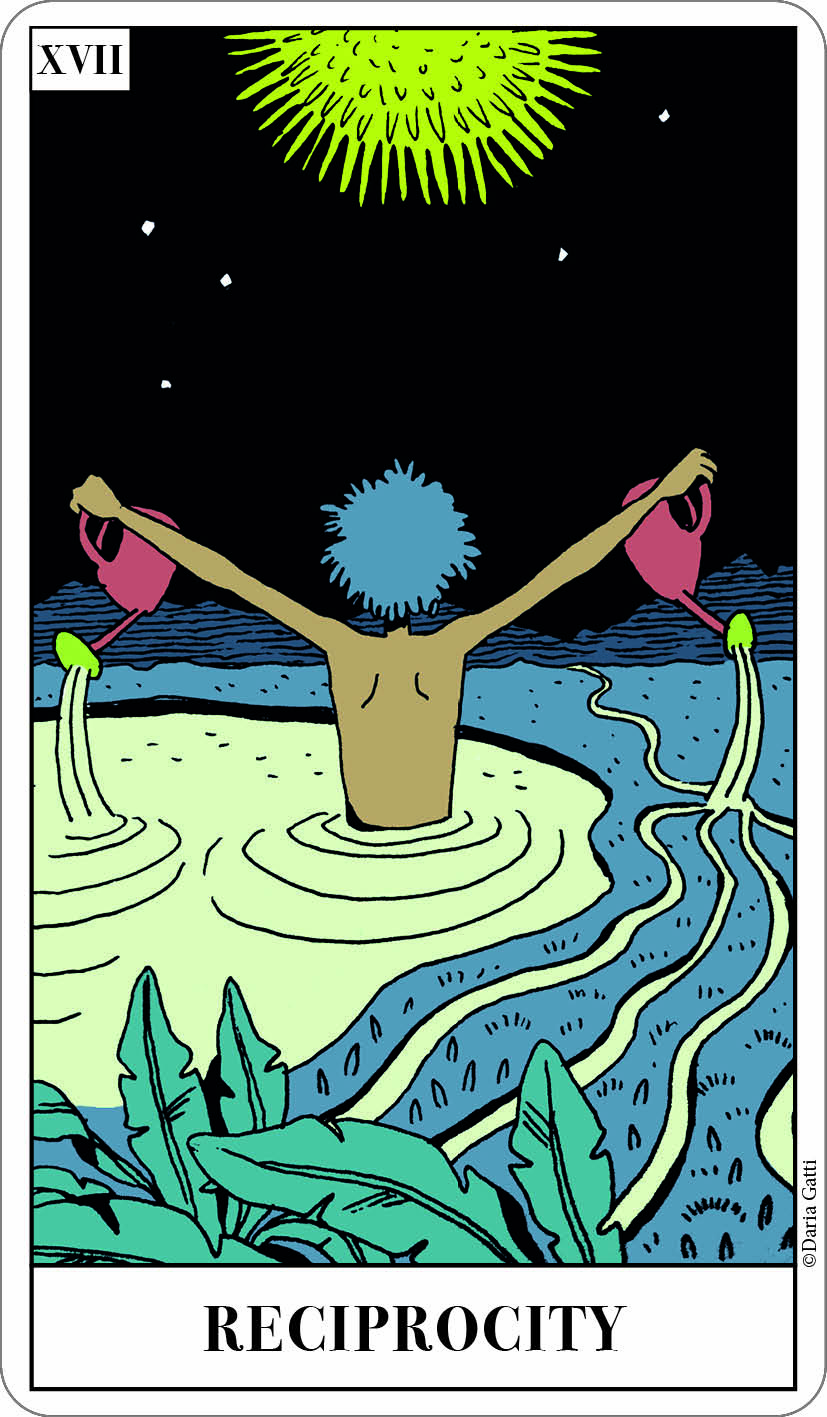
Reciprocity shows us a figure under the night sky, bearing water both to the earth and back to the waters. Reciprocity recognizes that in order to care for others, we need care for ourselves too – whether this care is coming from us, or from the people we are working with. We cannot make things grow when our cups are empty and dry. In hypermobile situations, where people are coming in and out of our organisations, or where we ourselves run from opportunity to opportunity, are we really setting ourselves up for a reciprocal relationship? Reciprocity means always making sure there is something left behind, so the cycle of creation and generosity can continue.
Reciprocity invites us to ask ourselves: What does care look like for you? When do you feel cared for and when do you feel like you are caring? How are we giving and sharing with others? What are our privileges and how can we put them on the line? But also, what do we need to feel fulfilled and how can we ask that of our environment? Can the reciprocity of our relationship be a clear and transparent part of our negotiations, contracts, and others?
Associated ritual: beyond privileges — Once we have identified our privileges, we can put them to work. We can try and find ways to distribute them, use them in order to make space for others.
Step 1: Identify the privileges you enjoy. Browse through your institution, partners, audience… Search for the privileges that come with them. Whether their character is economic (stable or at least decent income), visibility (public outreach of your activities or your institution or office is situated in a highlighted area), network (your surroundings have knowledge and skills) or other.
Step 2: Translate the privileges into potential. Focus on one privilege and elaborate on its potential. See what it brings and imagine what someone else, someone who is maybe not yet present within your context, could do with it. Scout the NGOs in your area and see who they work with, take a walk and see which communities are present in the neighbourhood, and what their needs are. Who is in need of economic support? Who could use some visibility to support their actions? Who might benefit from knowledge gathered by your networks?
Step 3: Transform the potential into a direct action...
...and deliver it!
Inform your audiences about the work of a local NGO before your event. Make a note about them in your booklets. Donate five percent of your ticket income to support social workers in your area. Prepare a collection of warm clothes, sleeping bags and tents for homeless people. Use your newsletters, networks and PR to spread the voices of members of your community… There are many things that could be done. Even a small action is valuable.
Over time, make a small collection of Beyond Privileges actions and share them with your fellow colleagues, partner institutions, update them on your website.
8. The Mirror (based on The Moon / Sense of Connection)
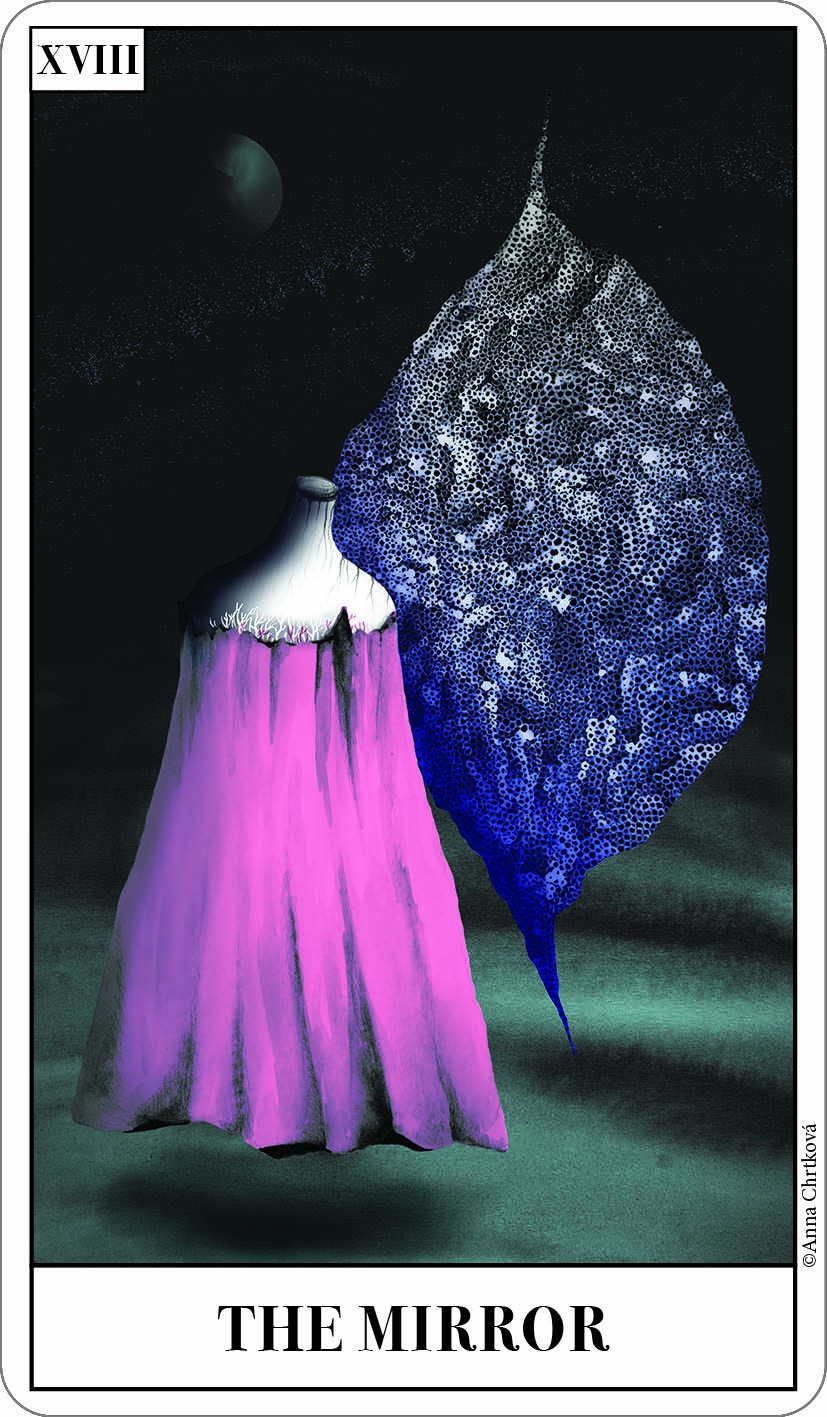
The Mirror talks about the need for multiple perspectives. Sometimes we need to look at ourselves, our practices and patterns of behaviour, and sometimes we need to look at what is behind us, or around a corner. Though one should also be aware that a mirror can transform – make things seem bigger or smaller, or further away.
What we see in the mirror is just a reflection. A reflection that has cracks, or can cast shadows. To look through a mirror doesn’t mean to try to see the things as they are, but to shift our focus to the reflection as image in and of itself, showing us what we need to see. Using a mirror may help to find focus, to step out of fixed narratives and ways of perception. The Mirror invites us to ask ourselves: How do we see ourselves/our organisation? How do we think others see that? What happens when we focus on a detail? What is unveiled? What remains hidden?
Associated ritual: reflection — Reflection proposes a way to obtain an insight into your practice by observing the practices of your colleagues from the field.
1st – Take a close look at the work of your colleagues. This can be an institution working in the same field, an artist with a similar approach, a specific organisation that is delivering similar services or ideas…
2nd – Observe both the negative and positive practices. What are things you tend to criticise or define as problematic? What are the activities that are tickling your imagination? What actions do you see as underdeveloped and which of them do you identify with?
3rd – Focus on the notions of: connection, place, break, generosity, multiplicity, or define those that you find significant.
4th – Use these notions as lenses to write down your ideas about the observed practices. Create a small mind map of your observations.
5th – Now take a look at your work. Take a carbon paper or a foil or any other transparent material and apply it on top of the map of your observation. Use a pen and start working on the reflection. Make a map of how your work relates to these observations. Search for translation of your previous notes and see how they project in your practice.
How do the things you find problematic appear in your work? Can you see similar patterns? How could you implement the inspirational activities in your way? Based on the observation, what kind of underdeveloped actions of yours come out?
Learn from your environment. Both from the positives and the negatives. Reflect your observations onto your practice.
Work with the Reflection when you have doubts, when you notice you are offended by a practice or when you encounter a highly inspirational event/person/...
9. Joy (based on The Sun / Sense of Break)
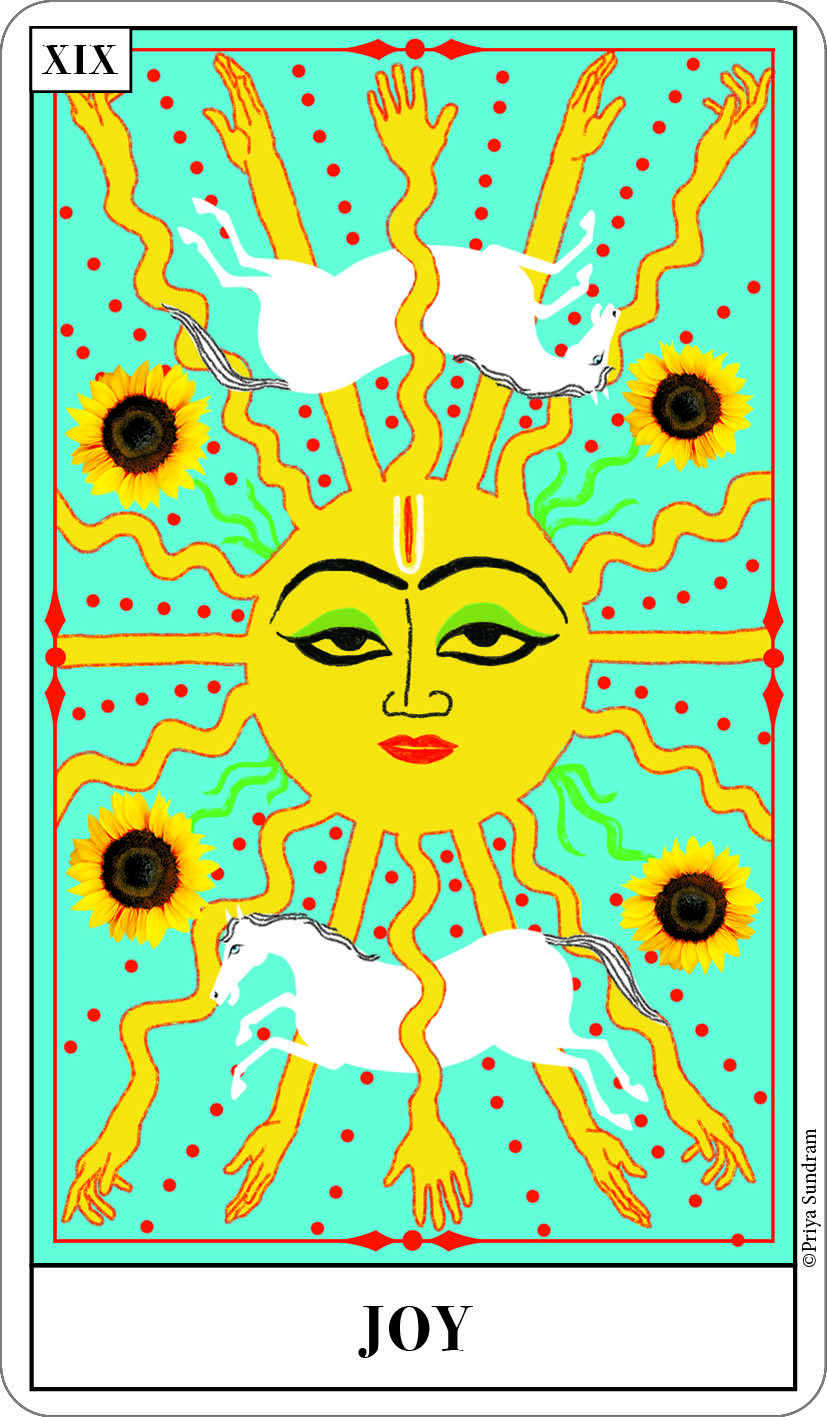
Joy can be expressed as a movement of coming into being and unfolding towards others. Much like the first cracks in a seed, joy needs to get out and do its transformative work. One of the first impulses to collaborate (trans-nationally) is the joy of being together, of collaborating, of exchanging ideas and points of views. A bursting out of ourselves together. Your free spirit may vagabond and joy may come as an alternative way of doing things.
Hospitality, as the joy of hosting, is about welcoming other people into your home to spend time together. The word hospitality comes from the Latin hospes, which came from the word hostis, which originally meant ‘to have power.’ Hospitality is all about the art of sharing power through joy.
‘Joy doesn’t betray but sustains activism. And when you face a politics
that aspires to make you fearful, alienated, and isolated, joy is a fine act of insurrection.’
(Rebecca Solnit, Hope in the Dark, 2016)
The Sun, with outstretched hands, is comforting and welcoming. The many hands of collaboration doing their thing but working together. The sunflowers referencing the traditional tarot card of the sun. They are joyful, strong flowers nourished by the sun. The white horses of innocence and perhaps travel, visually drawing on Islamic painting.
Joy invites us to ask ourselves: As a host, as a traveller or as a non-mobile practitioner, what brings me joy in collaboration, how do I valorise it? How do you find joy in what you’re doing? To which values is joy related in your practice? How can you make the joy of collaborating trans-/postnationally grow? How does it sustain your practice? How can you value joy within your organisation? Can you plan for joy and celebration?
Associated ritual: two spoons — It is time you were travelling again.
You are exploring new places, cities, nature. And again, you are about to return home. You are bringing with you new experiences that you do not want to keep just for yourself, you are eager to share them. Before your departure, borrow a small spoon of your morning coffee or tea. Do it in silence, without anybody noticing it. Enjoy the feeling of secrecy. When you return home, unpack your things and put a spoon on a visible spot with a name of a destination where you took it from.
Let the time go by.
When you travel again, repeat the action with a spoon.
Come home, put the second spoon next to the first one. Now think of a friend you haven’t seen since the past two travels or someone who is not allowed to travel as much as you do or someone you know, who had a long-term interest in visiting the place you have been to. Invite the friend that comes to your mind to the local coffee place. Order a tea or coffee for both of you. Take those two spoons from your travels and use them to stir your drink. Tell your friend about your travels, about the destinations, experience, things you saw...
When you finish your drink, keep the spoons on the coaster that goes with the coffee or tea. Let the spoons inhabit a new environment.
10. The Call (based on The Judgement / Sense of Place)
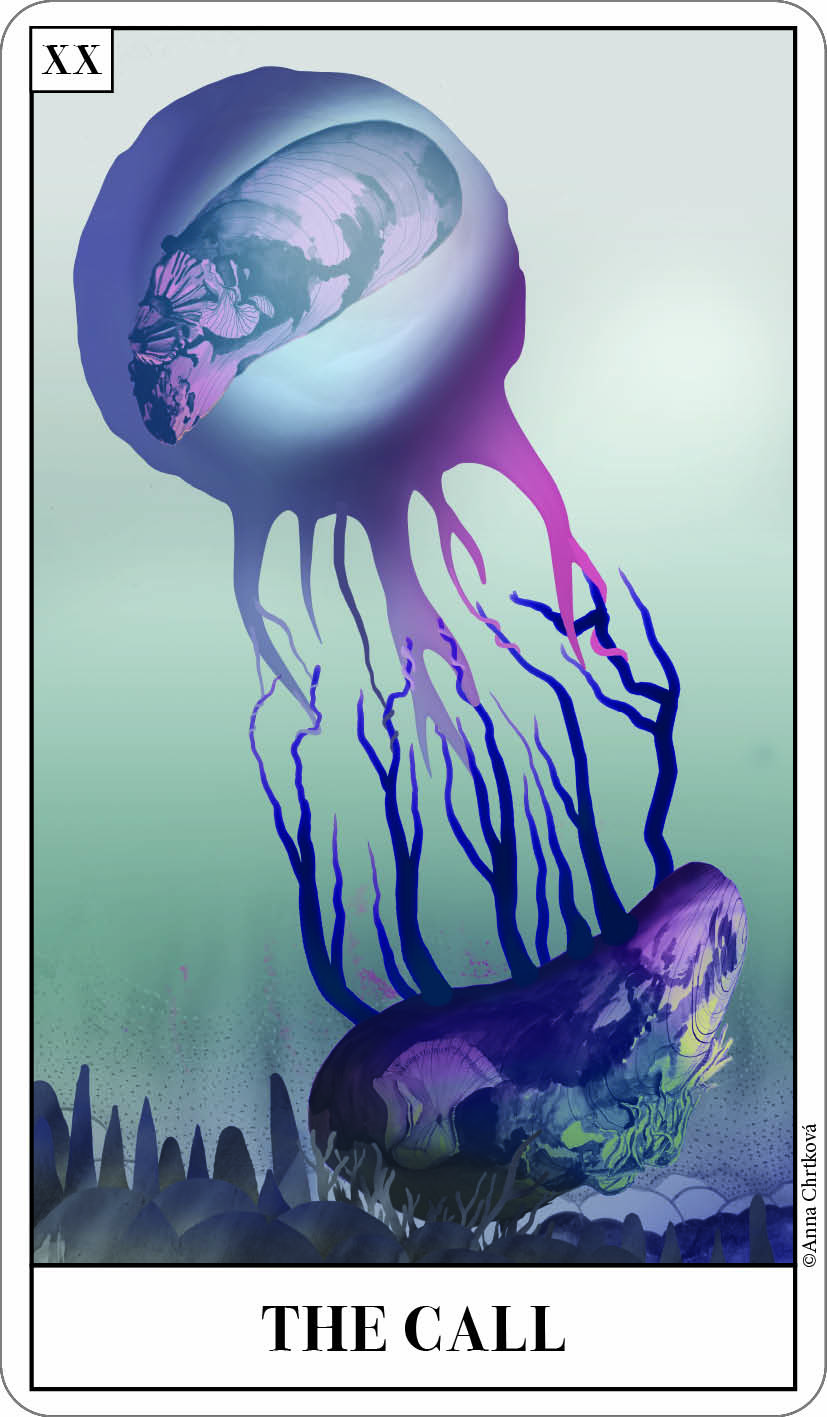
The Call is the first voice that we hear. Coming from outside, or from inside of us. It stands for new beginnings, and rising to the occasion. The archetype of The Call has two sides. On the one hand we can think of who is calling. The ones who let their voices and ideas travel into the world. The ones we might be listening to? On the other hand, we can think of who is being called, the one who is lured by the voice of the call. The importance that connects them both is a deep listening. Deep listening requires a state of openness, being receptive and pausing the desire to react. A call desires to be heard and to be answered. The calls are the first rays of sunshine touching the earth in spring. To answer a call, one needs intuition and empathy to establish an understanding. One needs to be certain of what is calling you, in order to act on that call.
The call invites us to ask ourselves: What are we calling out into the world? Who is reacting to our call? What voices are calling us? When do I experience a state of deep listening? Are there situations in which I could practice more deep listening? How does it feel to be ready? What is the impulse behind making the call and behind answering it?
Associated ritual: the email — The Email proposes to bring new elements to the never-ending communication cycle: joy, care, affinity.
Focus on one contact, one person you work with – this can be a person you haven’t met yet, or a long-term colleague. Write an elaborated letter in which you share your mood, insights from your personal or professional life. Simply go beyond the simple message that you need to deliver, make the person on the other side of the communication pleased.
Transform the function of the medium, expand its possibilities.
Variation: Look at your past open call or at a situation when someone wanted to apply to work with you, or simply when you had to decline someone (go once again through this person’s proposal). Write to this person with hindsight, ask what this person is doing now, establish the connection.
11. World (based on The World / Sense of Place)
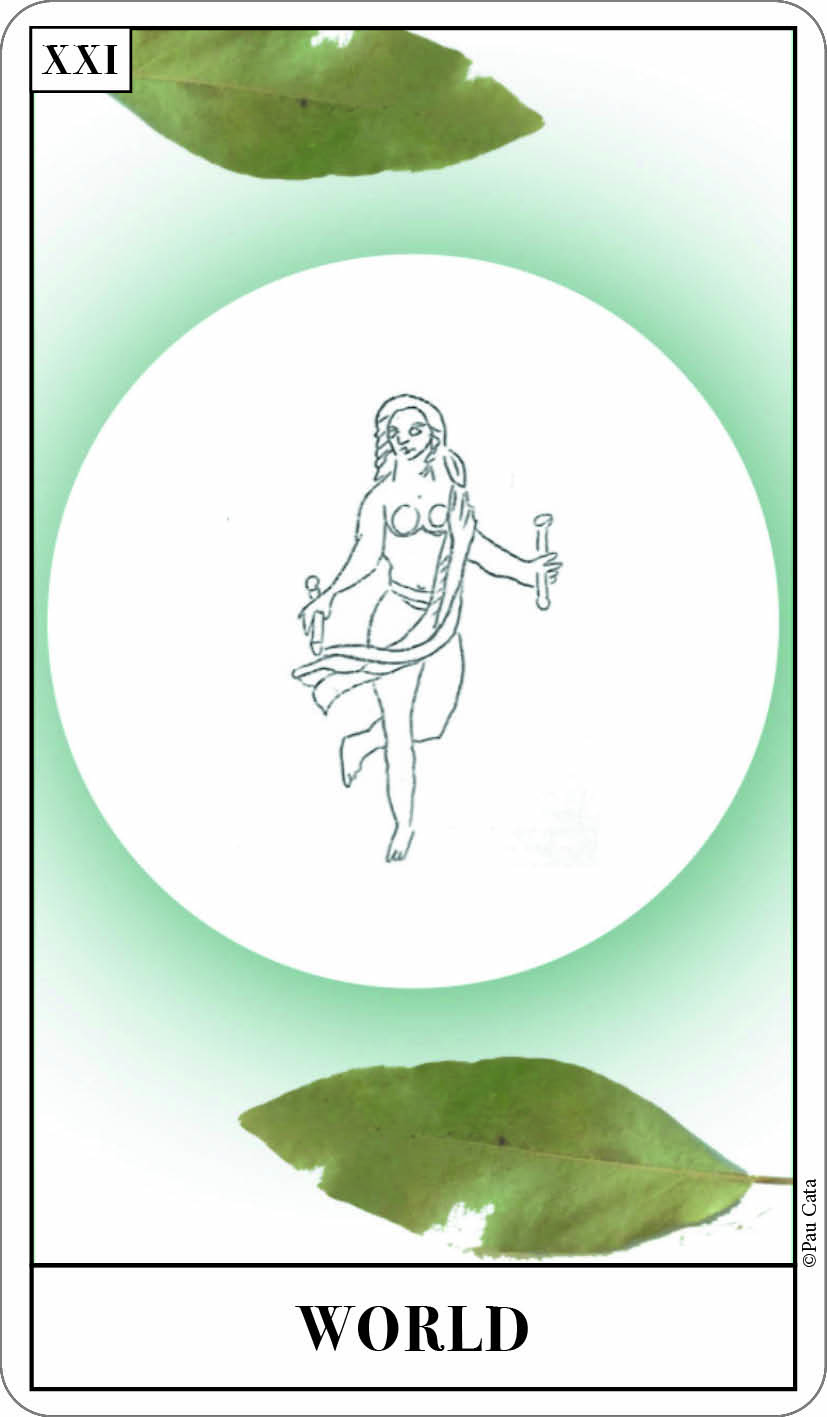
The lack of any solid ground in the World may seem ironic. The figure representing World has no gender, inhabits the above and the below, is suspended between the heavens and the earth. World symbolizes balance and evolution; a cycle has come to an end, and a new one is about to begin. The world is a unity that is ever-changing, dynamic, and regenerative. The world is the endpoint of the Traveller’s journey; what began as an undifferentiated space, has become a place endowed with value and care. In the world the senses of multiplicity, generosity, place, break and connection have been integrated.
World invites us to ask ourselves: What makes you feel fulfilled or balanced? Who or what is needed for you to have that feeling? When has a project felt whole and fulfilling? What was needed to have that feeling? What are the long-term connections that you are creating in your life, practice or organisation? Can suspension and quietness also become a way to move? When have I experienced both quietness and movement simultaneously?
Associated ritual: care — Care is more of a reminder than a ritual, but still it proposes an action.
Reserve one day per month (or find another period) to dedicate your working hours to your team and to yourself. Rearrange your office, bring new plants, make it more comfortable. Spend some quality time with your colleagues, help them with their duties, discuss your moods, share your fragility. After work, accompany your colleagues to the safety of their homes – take a long walk with them and avoid public transport if possible. Care for your team and for yourself is also work!
Using the archetypes and rituals
The Archetypes and tarot are developed as a tool to ask yourself questions about your own practice or organisation. Or to look at your work from a different perspective. There are different ways of using this proposal. You can take the card descriptions and the questions we have proposed as an inspiration, but remember that it is your own reading that will be important to your situation. Look at the archetypes we propose and let them speak to you, make them your own.
Below we propose some ways of reading and some spreads for the cards, inspired by some classic tarot spreads. Play around with these proposals and try out the ones that speak to you most.
You can do these spreads on your own, or as a group. When reading as a group, pay attention that everyone can bring their view to the table.
In general, tarot works best when you formulate an open question about your practice or your organisation. Think of a place where you are stuck, or a practice you would like to change. What is bothering you in the situation, what are you doubting about? Put both the context and the issue into an open question; meaning a question that cannot be answered by a simple yes or no.
For example: As an artist I feel quite lonely in my work, however I am often working in collaboration with others. In that case I could ask myself: What should I pay attention to in order to involve my peers more in my work?
When reading a card, before looking at the explanation, study the image. What do you notice first? What does it remind you of? How could that reflection be related to your practice? What else is there that you did not see right away? What associations do you make with the image, or with the explanation?
A card a day
Formulate your question and draw a single card. Read the card and notice what it brings up in you. See if you can recognise what the card proposes during the day. At the end of the day, either write down these observations for yourself, or discuss them in your team.
Alternatively, implement the ritual connected to the card. At the end of the day, observe how it has changed your day and your reading of the card.
Classic three-card spread
Formulate your question and draw 3 cards. Put the cards next to each other. Turn over the cards one by one.
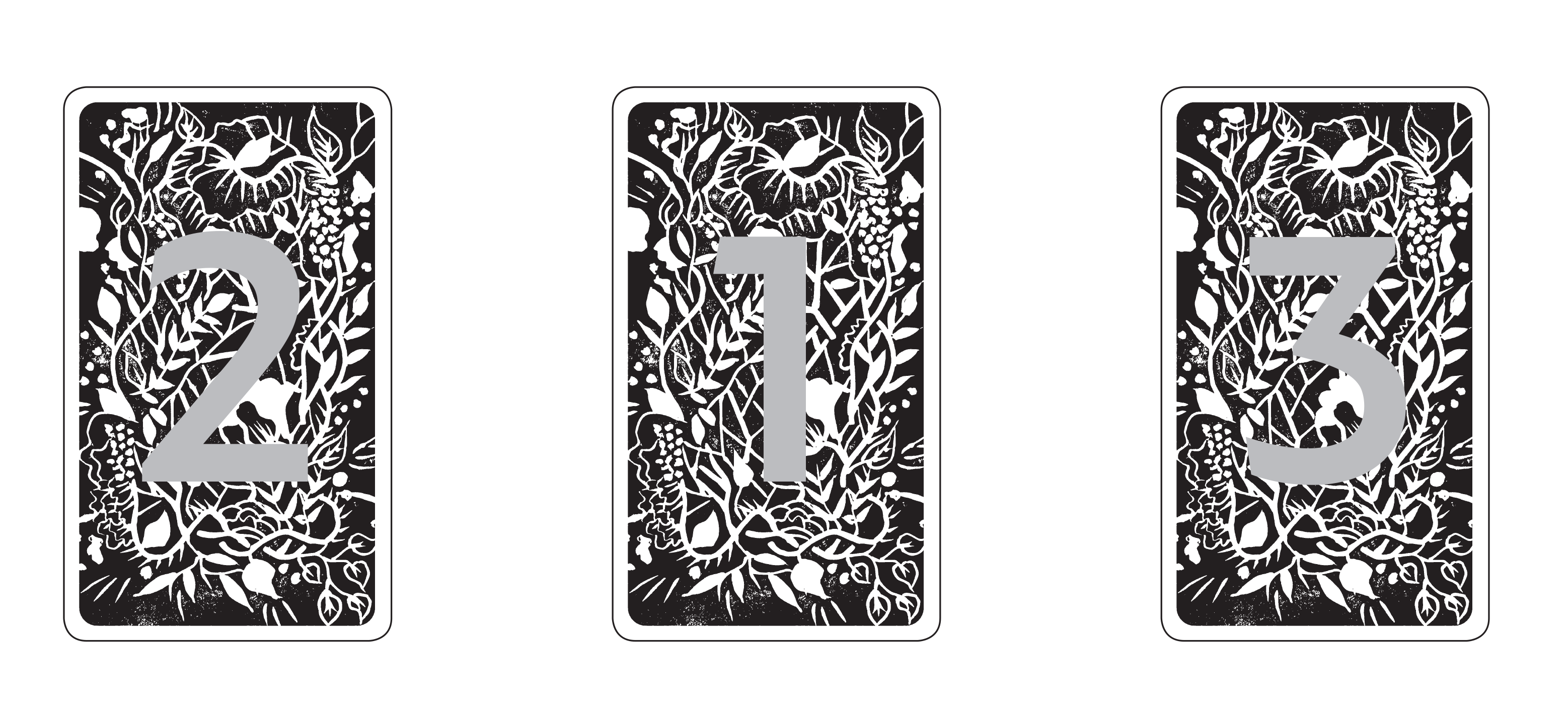
1. The middle card represents the ‘now’, the situation where you find yourself. How does the card speak to you knowing that?
2. The left card represents a lesson from the past. Read the card and see how this has been true in the past. When has what the card speaks of been your experience in the past? How can that experience help you now? Think about what was present at that time. What did you do, and who else was there?
3. The final card on the right represents the future. Read the card and think of what you would like the outcome of the current situation to be. How can the advice of the card help in that? Where can you already see that on the horizon? What could be a first step you can take in that direction?
Variation of the classic three-card spread
A variation on the spread above can be used for specific issues. You can change past, present, future into other factors that are of importance for your situation.
In the example above, of being lonely in my practice as an artist, I could ask the cards:
- In what situations do I feel lonely in my practice while collaborating?
- What is missing in the context?
- What are the kind of people or practices I would like to connect to?
Or when setting out to travel:
- What to pay attention to before the travel?
- What to pay attention to during the travel?
- What to pay attention to after the travel?
Short Celtic cross
Formulate your question and draw the following cards one by one. Put them in the positions of the Celtic cross.
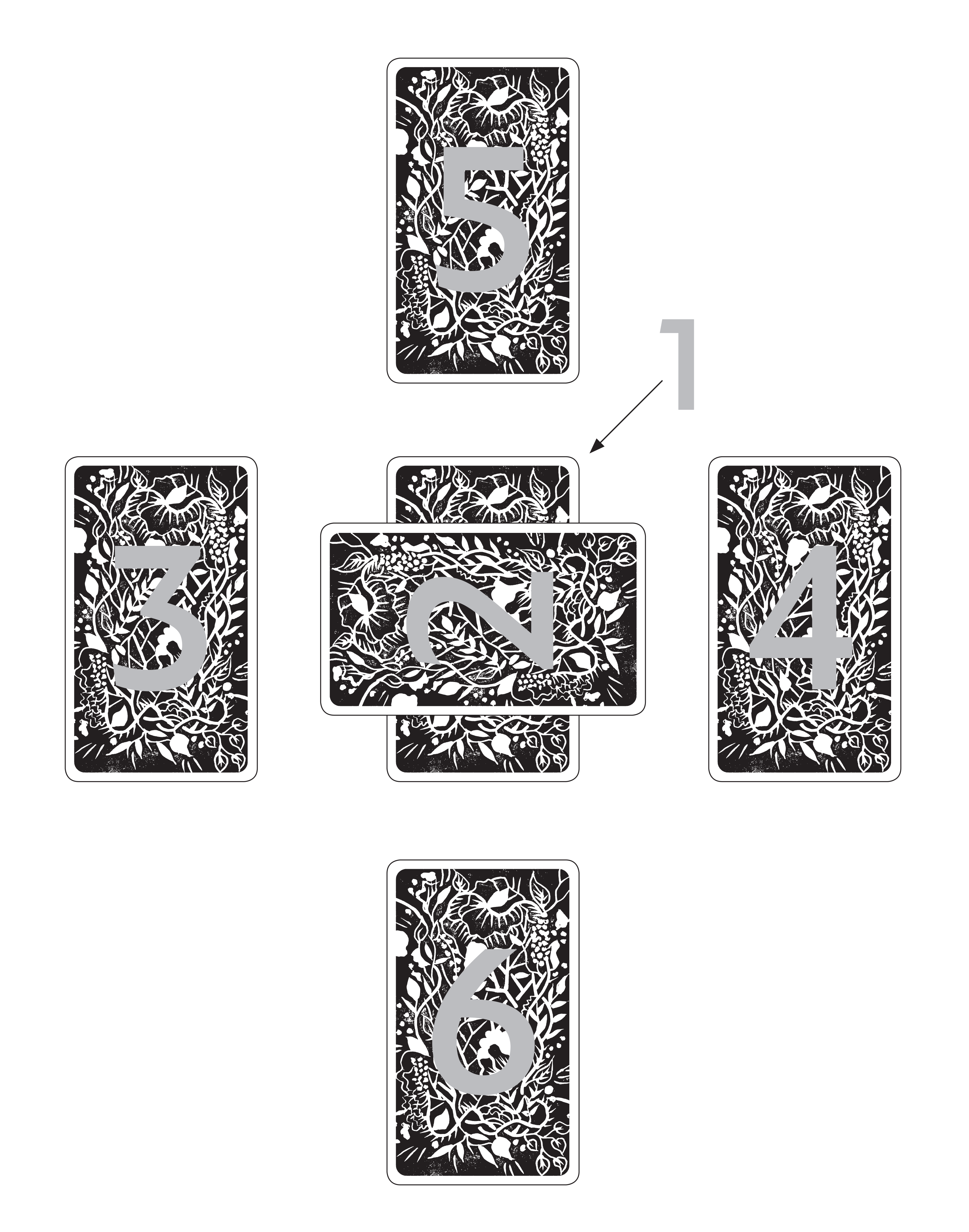
1. The middle card represents the ‘now’, the situation where you find yourself. How does the card speak to you knowing that?
2. The second card represents what is ‘crossing’ this situation. What is the problem? Can you define it more clearly?
3. The left card represents a lesson from the past. Read the card and see how this has been true in the past. When has what the card speaks of, been your experience in the past? How can that experience help you now? Think about what was present at that time, what did you do, and who else was there?
4. The final card on the right represents the future. Read the card and think of what you would like the outcome of the current situation to be. How can the advice of the card help in that? Where can you already see that on the horizon? What could be a first step you can take in that direction?
Cards 5 and 6 can be seen as moving factors that make the present turn into the future.
5. What is above? What is on your mind at the moment that might be blocking the situation? Are you preoccupied by higher goals? Are there some values you would like to push more?
6. What is below? Is there anything that you are not seeing? Are you not acknowledging some of your needs? Are there hidden motivations at play? Is there something you are scared of that you have to resolve?
Four advice cards
The four advice cards can be used on their own, or in combination with the classic three-card spread or Celtic cross. The four advice cards lie in one vertical line, from bottom to top.
Formulate your question and draw the following cards one by one.
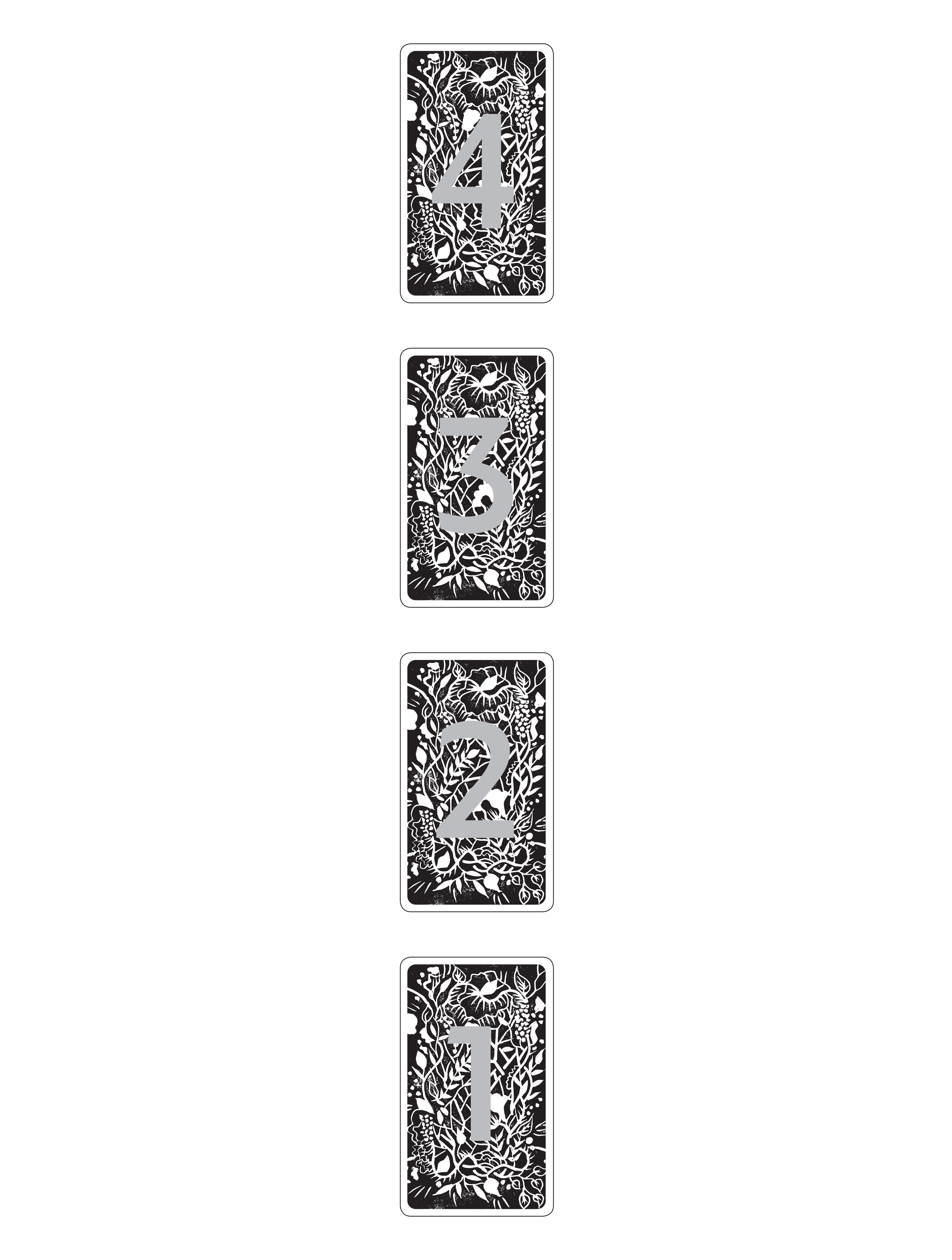
1. The first card is a mirror. How do you see yourself or your organisation in this situation? What do you hope others see?
2. What are the resources at your disposal? Resources can be money, people, skills, knowledge. What do you already have that can change this situation? Where is what the card speaks of already present in your life or organisation?
3. Will give you advice on your fears and expectations. What are you afraid of, in what the card speaks of? What would you expect of what this card proposes? How can the card help you in overcoming some of your fears? Does the card question or empower your expectations?
4. An alternative outcome. How can this card play into a preferred future?
How to use the rituals and make your own?
We chose to work with rituals, understanding them as instigators of change and transformation. A ritual is not metaphysics, rituals propose materialist and practical practices that can incorporate magic into daily life. A ritual can produce small or big shifts in our perception, changing us and our surroundings. We chose to look at rituals of passage – moving from one paradigm into the next. A rite of passage is understood to have three main phases: separation, transition, and incorporation. In the first stage a separation is made with the old identity. This can be through physical or symbolic acts. In the transition stage one is ‘in between’. The stage is marked by liminality, ambiguity, or disorientation. The old identity is left behind, but the new identity is not yet found. This stage is often found to create a bond or community between those participating in the ritual. The final stage is incorporation; the new identity is confirmed and acknowledged by the community.
The proposed rituals, linked to the archetypes, are only certain patterns of possible actions. Each of the rituals could be adjusted to your needs, to the issue you are following or extended with your creativity. Even though the results may be invisible at first sight, try to repeat some of them periodically, observe what changes. Some rituals are narrated to be practised individually, some are designed for groups or institutions. Yet each of them could be translated to whatever situation you are in. Rituals are flexible, always ready to work for you if you commit your time and energy to them.
If you don’t find the proposed list satisfying or if you want to address a different issue, the easiest way is to design your own ritual, your own micro-action that can be performed to shift your reality. There is no right way or one method to create a ritual, but we want to share a few tips that might simplify the creative process.
1. Call the evil
- First. Identify the problem you want to address. You can call tarot cards to help you find the struggle.
- Name the issue.
- Play with it (again you can use tarot cards to go deeper into it), try to see it from all sides; take a distant and a close-up view.
2. Reconciliation
- Second. Befriend the struggle.
- Accommodate it within you. See what feelings it provokes. Be with the feelings.
3. Get it out!
- Third. Exorcise the struggle!
- Find a way to translate the struggle into an action that tackles it, makes it visible, gives it another form, makes it possible to share it...
- The action could be very soft – caressing the struggle and flattening its sharp edges. Or it can be radical – going directly to its essence.
- Use your creativity, search for videos, performances, practices that are dealing with a similar struggle. Be inspired by them.
- Involve others.
4. Write the ritual down
- Take a piece of paper and write down the guidelines on how to practice the action.
- After you test it, make edits if needed.
- Share it with your colleagues.
For example: As an artist I feel quite lonely in my work. However, I am often working in collaboration with others. In that case I could propose: At the beginning of each group studio session you dedicate thirty minutes to share insights of your everyday lives/or once a week at the last hour of your solo session you invite a friend to join you to share your work.
Remember that rituals don’t necessarily need to be created just for yourself. You can design a ritual for your colleague, for your friend, or ask them to design a ritual for you. You can make one for a guest that you are about to host or a host you are about to visit. Design a ritual as a birthday present or an anniversary gift for your institution.
Virtual exhibition: ‘On the complexities of the journey’
Inspired by the power of both archetypes and rituals, and in order to further enhance and complement them, we propose to continue stressing and enriching this complex journey. To do so, we invite you to navigate and contribute to a constellation of other sources.
The movement of bodies, knowledge(s) and practices is a fundamental aspect of life. Movement and change are at the core of our multiple perspectives. Within this movement, within constant change, those that practice the creative act – artists, curators, and researchers – inhabit ambiguous lands. On one hand, they have become privileged carriers of new knowledge(s). On the other, the urge to travel, to be mobile, has become a privilege. Indeed, self-congratulatory hypermobility, the lure for the other, artistic monoculture, exclusion, and ecological neglect increasingly condition the practice of the journey.
It is in this context from which ‘On the complexities of the journey: a prototype in the making’ proposes an unfinished virtual exhibition of knowledge(s) curated collaboratively. This museum without walls will always be unfinished. Its content, the outcome of a set of questions posed to the RESHAPE community, is in need of care and contribution. We encourage you to care and contribute by proposing new content to continuously enlarge this constellation.
This virtual exhibition is articulated through five floating spaces. Each of these spaces is dedicated to the five senses previously described. Sensing involves understanding and becoming aware of our surroundings, unconsciously figuring something out, to enhance a multiplicity of shades of meaning. To start unfolding these senses, ‘On the complexities of the journey: a prototype in the making’ invites you to navigate through an unfinished universe and its constellations. In each of them, neglecting hierarchy, we, as hosts, have gathered a selection of artworks, gifs, projects, texts, and interviews contributed by the whole RESHAPE community as well as the archetypes and rituals proposed within the transnational/postnational team. Following the instructions made above, which are also accessible through the ‘On the complexities of the journey: a prototype in the making’ web, we invite you to put them in practice and if you are happy to document and share the processes and its outcomes, we will include them in the visual exhibition.
Through this constellation in the making, we propose a commencement to understand the journey, not only in its physicality but also as an essential part of what constitutes our lives.
To add to the existing, send a link to a copyleft artwork, project, text, or interview to the email you will find on the project’s website. Your proposal should be accompanied by a short description of the piece specifying in which of the five senses you want to include it in.
From now on, you are also part of acomplexjourney.art.
Developed in the framework of the RESHAPE trajectory Transnational / Postnational Artistic Practices.
This text is licensed under the Creative Commons license Attribution-ShareAlike 4.0 International.

